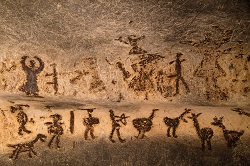Genomics sheds light on the birth of agriculture
Around 10 000 years before present (yBP), the migration of human communities across south and central Europe from the Near East introduced farming and animal breeding in Europa, replacing the pre-existing hunter gatherer (HG) way of life with limited interbreeding. By contrast, widespread adoption of farming practices in northern Europe came about mainly as a result of cultural contact, again with restricted gene flow. The EU-funded NeoGenHeritage project selected the Iberian Peninsula at the western fringe of Europe to study the dynamics and demographic changes of this Neolithic transition. Researchers used this data with the prehistoric routes of migrations that swept across Spain and Portugal and then northwards through Andorra. Combining cutting edge technologies in ancient DNA remains and human population genomics, NeoGenHeritage researchers generated whole nuclear genome data from prehistoric remains. The next step was to analyse these genomes in the context of ancient and modern population genomics. As Professor Guido Barbujani, project coordinator explains, “This approach enabled us to investigate the genetic affinities of ancient north and south Iberian populations in the context of worldwide human genomes.” Bridging the information gaps with state-of-the-art genomic data Before NeoGenHeritage research, data was scant – only one complete Mesolithic genome from around 8 000 yBP and some early and mid-Neolithic remains existed. “Limitations with this data are that most of the samples come from northern and central Spain, which prevents comparison of the Atlantic and Mediterranean areas that, as archaeologists tell us, may have different demographies,” Prof. Barbujani points out. A further problem was that previously analysis was hampered by a shortage of genetic markers. NeoGenHeritage therefore designed a sampling strategy to recover contemporary human remains from the Neolithic transition in the Mediterranean and Atlantic areas. Analysis of these complete genomes can detect otherwise elusive differences between the ancient individuals from these two shorelines. Stepping through the DNA changes along the migration routes Analyses based on genome wide data support a mixture of cultural and demographic diffusion in both the north and south of the Iberian Peninsula. Genomes of all the post-Neolithic samples have two major components typical of west HGs in Europe and early farmers from the Near East. However, after running tests for genetic admixture, a biogeographical ancestry analysis, some differences were discernible between the HG populations from the Atlantic and the Mediterranean areas. The samples from the Atlantic side had more in common with the Mesolithic HG from northern Spain. “The simplest explanation for this finding is that the Atlantic and Mediterranean populations of Iberia were already differentiated in pre-Neolithic times,” Prof. Barbujani comments. “Another reason may be localised admixture between incoming farmers and the pre-existing HG gene pool.” Analysis for future elucidation Prof. Barbujani describes work that is anticipated to explore and elucidate the complex, dynamic genetic processes at work during the Neolithic Revolution. “Continued analysis is going to involve simulation of different levels of genomic diversity with varying evolutionary scenarios and comparison with observed real-life data.” Another option the team would like to pursue is to integrate a similar study on Cheddar Man whose 10 000-year-old remains rose to fame as the first modern Briton with blue eyes, dark to black skin and dark curly hair. This would enable a better understanding of the relationships among European Mesolithic communities. To sum up the social and genetic aspects of NeoGenHeritage research results, Prof. Barbujani stresses that, “Our ancestors have always ventured into new territories, and on their way, they have met and admixed with other populations. The result is a rich patchwork of genomic components, difficult, or impossible, to trace back to a single geographic origin.”
Keywords
NeoGenHeritage, genome, Iberia, Neolithic, hunter gatherer (HG), Mesolithic







